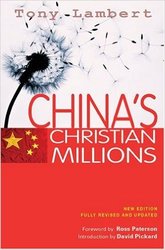China’s Christian Millions by Tony Lambert, OMF International and Monarch Books, 1999. ISBN 1 85424 431 0, paperback, £8.99. In the US$ 19.99 plus $3.20 postage. Special introductory offer for ChinaSource readers while stocks last: US$ 12.99 plus $3.20 postage. Order from OMF Books USA by calling toll free 1.888.663.2665; fax 1.303.430.4165; email <OMF_Books_USA@ CompuServe.com>
Reviewed by Alex Buchan
Books on the Chinese church tend to be one of two types: weighty academic affairs showing how great erudition is no defense against naive conclusions, or super light testimony-fests from evangelicals giving the impression that every Christian in China has been miraculously healed from a rare disease or has spent 20 years in solitary confinement. Few books successfully offer a balanced perspective on what is admittedly a complex subject; that Tony Lambert has just produced one that is both informed and readable is a welcome achievement.
Lambert’s book, titled China’s Christian Millions, represents the fairest and best introduction to the contemporary Chinese church that I have seen. His recipe is obvious—mix facts, statistics, history, documents and anecdotes into a good read for the non-specialist. Not only do you get lots of stories, but you end up actually knowing, for example, what the Three Self Patriotic Movement is, or the importance of Document 19 for church-state relations.
Lambert is well qualified as a guide to the Chinese revival. As OMF’s longstanding China researcher, he translates more letters and documents from China’s Christians than possibly anyone else. Still, he has gotten out from behind his desk often enough to encounter the revival at the grassroots, as shown by many of the stories that are the result of his own research. He created a splash in 1991 with the publication of the Resurrection of the Chinese Church, the first serious work to provide documentary evidence that house churches were a far bigger force than most academics reckoned at that time. Ironically, he raised an even bigger splash in 1994 when he released a set of statistics in News Network International with the provocative claim that there were “not more than” 35 million Christians in China—a claim that did not endear him to evangelical ministries that routinely traffic in figures of 60 million plus. This book does not contain an actual estimate, though he dismisses figures of 80 to 100 million as unproven, but if you add up his figures they come to around 40 million today.
His task, in his own words, is to provide (a) an overview of the scale of revival, (b) some reasons why God has worked in this way, and (c) some sobering truths we need to learn. Out of fourteen chapters, thirteen deal exclusively with the overview. The first four sketch the basic outlines of the registered and unregistered church. His treatment of the Three Self Patriotic Movement has three characteristics essential to a balanced perspective: he accepts progress, acknowledges repression and avoids over-simplification. If in that chapter he has been addressing evangelicals that tend to write the TSPM off as a hopelessly compromised institution, his chapter on the house church addresses those who would tend to dismiss house churches as dangerous extremists. He traces the confusion back to the ambiguities of Document 19 which states that “Christians undertaking religious activities in home-meetings…should not, in principle, be permitted. But they should not be rigidly prohibited.”
The next nine chapters go through the revival topic by topic, drawing out the great diversity within Chinese Christianity. The chapter on Henan, the heartland of the revival, is invaluable, and the chapters on minorities, heresies and intellectuals are also excellent.
Two carps do not detract from the overall impact. One is that for all his attempts to make the book readable, the writing is often dull. Lambert’s skills as an analyst greatly exceed his abilities as a storyteller. Anecdotes often lack color and emotion apart from excerpts from testimonies. I also question his assessment of the August 1998 United Appeal by ten house church leaders. He hails the document as one that “marks the coming of age of the house church movement!” That may be a bit overblown since it is hardly typical of house church leaders to issue appeals to their government via visiting Western journalists and append their names at the bottom.
In my opinion, the best chapter, by far, is the last one. Here Lambert conveys great passion as he answers the question “Why did China experience this great revival?” He brilliantly critiques both Chinese Marxist and Western academic explanations, then adds devastatingly, “It is worth noting that suffering is absent from the list of reasons for church growth, from both the Chinese and Western academics. (From the former because of political constraints, from the latter probably because it is outside their experience.)” He sees the lessons of the Chinese revival as a combination of respect for the authority of Scripture, obedience, prayer, repentance, seriousness, and a true valuing of Christ and his cross.
The question is whether these are the fruits of revival rather than its causes. After all, if revival is about adhering to the inerrant Word, why are America’s conservatives not experiencing revival also? Are Western Christians really that bad at praying compared to their Chinese brothers and sisters? I felt his crucial question— where did the revival come from—remained unanswered. But then, perhaps it is the nature of revival (contra Finney et al) to be mysterious!
For introducing someone to the story of the contemporary Chinese church, or even if you want a fast-moving refresher of key events and documents, there’s not a book to touch this one. It’s even valuable as a reference book, containing a province-by-province summary of the church in a lengthy appendix. And, for the scholar, it whets the appetite for Lambert’s updated version of The Resurrection of the Chinese Church due next year.
Alex Buchan
Alex Buchan is the Asia Bureau Chief of Compass Direct and has been writing on the Chinese church since 1987.View Full Bio
